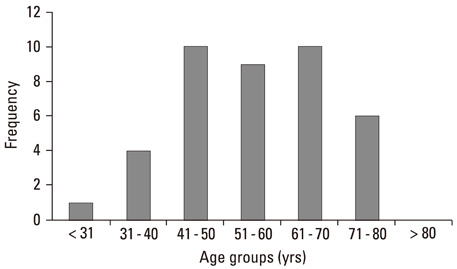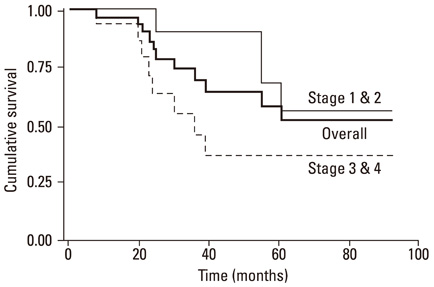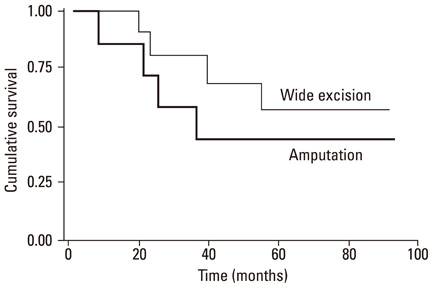Treatment and Outcomes of Melanoma in Acral Location in Korean Patients
- Affiliations
-
- 1Department of Dermatology and Cutaneous Biology Research Institute, Yonsei University College of Medicine, Seoul, Korea. kychung@yuhs.ac
- KMID: 1805195
- DOI: http://doi.org/10.3349/ymj.2010.51.4.562
Abstract
- PURPOSE
A retrospective study was conducted to review the treatment and outcomes of mainly melanomas in acral location in a single institution in Korea, and to evaluate the prognostic significance of anatomic locations of the tumor.
MATERIALS AND METHODS
A retrospective review was completed on 40 patients between 2001 and 2006 to obtain pertinent demographic data, tumor data, treatment characteristics, and follow-up data.
RESULTS
Forty melanoma patients were identified and analyzed. Of these, 18 were male and 22 were female patients and the mean age at the time of diagnosis was 55.9 years. Of the tumors, 65% were located on the hands and feet with acral lentiginous melanoma being the most common histological subtype. Univariate analysis for the overall melanoma survival revealed that the thickness of the tumor and the clinical stage have prognostic significances. The most significant factor as analyzed by a multivariate analysis was shown to be the advanced clinical stage. Acral melanomas did not show statistically significant differences in the age at diagnosis, thickness of the tumor, stage, ulceration, and survival rates compared to non-acral melanomas. There was also no significant difference in the survival rate between the patients treated by amputation versus wide local excision in acral melanomas.
CONCLUSION
In Korean melanoma patients, thickness and advanced stages are significant factors for poorer prognosis. However, the location of melanoma did not have a significant prognostic value. In treating the melanomas in acral location, local wide excisions resulted in a similar prognosis compared to amputations.
Keyword
Figure
Cited by 4 articles
-
Clinicopathologic Features and Prognostic Factors of Primary Cutaneous Melanoma: a Multicenter Study in Korea
Jung Eun Kim, Bo Young Chung, Chang Yoon Sim, A Young Park, Jong Suk Lee, Kyu Uang Whang, Young Lip Park, Hye One Kim, Chun Wook Park, Sung Yul Lee
J Korean Med Sci. 2019;34(16):. doi: 10.3346/jkms.2019.34.e126.Long-Term Survival Analysis and Clinical Follow-Up in Acral Lentiginous Malignant Melanoma Undergoing Sentinel Lymph Node Biopsy in Korean Patients
Su-Young Jeon, Jin-Woo Hong, Suee Lee, Sung Yong Oh, Young-Seoub Hong, Ki-Ho Kim, Ki-Hoon Song
Ann Dermatol. 2014;26(2):177-183. doi: 10.5021/ad.2014.26.2.177.Comparison of Melanoma Subtypes among Korean Patients by Morphologic Features and Ultraviolet Exposure
Hong Sun Jang, Jee Hung Kim, Kyu Hyun Park, Jae Seok Lee, Jung Min Bae, Byung Ho Oh, Sun Young Rha, Mi Ryung Roh, Kee Yang Chung
Ann Dermatol. 2014;26(4):485-490. doi: 10.5021/ad.2014.26.4.485.Clinical Outcomes of Immune Checkpoint Blocker Therapy for Malignant Melanoma in Korean Patients: Potential Clinical Implications for a Combination Strategy Involving Radiotherapy
Jeongshim Lee, Jee Suk Chang, Mi Ryung Roh, Minkyu Jung, Choong-Kun Lee, Byung Ho Oh, Kee Yang Chung, Woong Sub Koom, Sang Joon Shin
Cancer Res Treat. 2020;52(3):730-738. doi: 10.4143/crt.2019.598.
Reference
-
1. Jemal A, Thomas A, Murray T, Thun M. Cancer statistics, 2002. CA Cancer J Clin. 2002. 52:23–47.2. Dooley TP. Recent advances in cutaneous melanoma oncogenesis research. Oncol Res. 1994. 6:1–9.3. Chen YJ, Wu CY, Chen JT, Shen JL, Chen CC, Wang HC. Clinicopathologic analysis of malignant melanoma in Taiwan. J Am Acad Dermatol. 1999. 41:945–949.
Article4. Chang AE, Karnell LH, Menck HR. The National Cancer Data Base report on cutaneous and noncutaneous melanoma: a summary of 84,836 cases from the past decade. The American College of Surgeons Commission on Cancer and the American Cancer Society. Cancer. 1998. 83:1664–1678.
Article5. Luk NM, Ho LC, Choi CL, Wong KH, Yu KH, Yeung WK. Clinicopathological features and prognostic factors of cutaneous melanoma among Hong Kong Chinese. Clin Exp Dermatol. 2004. 29:600–604.
Article6. Ishihara K, Saida T, Yamamoto A. Japanese Skin Cancer Society Prognosis and Statistical Investigation Committee. Updated statistical data for malignant melanoma in Japan. Int J Clin Oncol. 2001. 6:109–116.
Article7. Lee MW, Koh JK, Kwon KS, Kim NI, Kim SW, Kim SN, et al. Clinical and histopathological study of cutaneous melanoma in Korea. Korean J Dermatol. 2003. 41:43–47.8. Moon SE, Cho KH, Hwang JH, Kim JA, Youn JI. A statistical study of cutaneous malignant tumors. Korean J Dermatol. 1998. 36:7–15.9. Hemmings DE, Johnson DS, Tominaga GT, Wong JH. Cutaneous melanoma in a multiethnic population: is this a different disease? Arch Surg. 2004. 139:968–972.10. Balch CM, Cascinelli N. The new melanoma staging system. Tumori. 2001. 87:S64–S68.
Article11. Cormier JN, Xing Y, Ding M, Lee JE, Mansfield PF, Gershenwald JE, et al. Ethnic differences among patients with cutaneous melanoma. Arch Intern Med. 2006. 166:1907–1914.
Article12. Jang KA, Kim JH, Choi JH, Sung KJ, Moon KC, Koh JK. A Clinico-histopathological study of malignant melanoma. Korean J Dermatol. 2000. 38:1435–1443.13. Park KD, Lee SJ, Lee WJ, Kim DW, Chung HY, Cho BC. Clinicopathological features of cutaneous malignant melanoma. Korean J Dermatol. 2007. 45:149–158.14. Lee DH, Kim YC, Cho SH, Lee MG. Clinicopathologic analysis of malignant melanoma. Korean J Dermatol. 2002. 40:914–923.15. Ries LA, Wingo PA, Miller DS, Howe HL, Weir HK, Rosenberg HM, et al. The annual report to the nation on the status of cancer, 1973-1997, with a special section on colorectal cancer. Cancer. 2000. 88:2398–2424.
Article16. Boyle P, Maisonneuve P, Doré JF. Epidemiology of malignant melanoma. Br Med Bull. 1995. 51:523–547.
Article17. Tsai T, Vu C, Henson DE. Cutaneous, ocular and visceral melanoma in African Americans and Caucasians. Melanoma Res. 2005. 15:213–217.
Article18. Morton DL, Davtyan DG, Wanek LA, Foshag LJ, Cochran AJ. Multivariate analysis of the relationship between survival and the microstage of primary melanoma by Clark level and Breslow thickness. Cancer. 1993. 71:3737–3743.
Article19. Garbe C, Büttner P, Bertz J, Burg G, d'Hoedt B, Drepper H, et al. Primary cutaneous melanoma. Identification of prognostic groups and estimation of individual prognosis for 5093 patients. Cancer. 1995. 75:2484–2491.
Article20. Vollmer RT. Malignant melanoma. A multivariate analysis of prognostic factors. Pathol Annu. 1989. 24(Pt 1):383–407.21. Breslow A. Tumor thickness, level of invasion and node dissection in stage I cutaneous melanoma. Ann Surg. 1975. 182:572–575.22. Bevilacqua RG, Coit DG, Rogatko A, Younes RN, Brennan MF. Axillary dissection in melanoma. Prognostic variables in node-positive patients. Ann Surg. 1990. 212:125–131.23. Hu S, Ma F, Collado-Mesa F, Kirsner RS. UV radiation, latitude, and melanoma in US Hispanics and blacks. Arch Dermatol. 2004. 140:819–824.24. Jemal A, Murray T, Ward E, Samuels A, Tiwari RC, Ghafoor A, et al. Cancer statistics, 2005. CA Cancer J Clin. 2005. 55:10–30.25. Rhodes AR, Weinstock MA, Fitzpatrick TB, Mihm MC Jr, Sober AJ. Risk factors for cutaneous melanoma. A practical method of recognizing predisposed individuals. JAMA. 1987. 258:3146–3154.26. Holly EA, Aston DA, Cress RD, Ahn DK, Kristiansen JJ. Cutaneous melanoma in women. I. Exposure to sunlight, ability to tan, and other risk factors related to ultraviolet light. Am J Epidemiol. 1995. 141:923–933.27. Elwood JM. Melanoma and sun exposure. Semin Oncol. 1996. 23:650–666.28. Gloster HM Jr, Neal K. Skin cancer in skin of color. J Am Acad Dermatol. 2006. 55:741–760.29. McCredie M, Coates MS, Ford JM. Cancer incidence in migrants to New South Wales from England, Wales, Scotland and Ireland. Br J Cancer. 1990. 62:992–995.
Article30. Cooke KR, Fraser J. Migration and death from malignant melanoma. Int J Cancer. 1985. 36:175–178.
Article31. Titus-Ernstoff L. An overview of the epidemiology of cutaneous melanoma. Clin Plast Surg. 2000. 27:305–316. vii32. Halder RM, Bridgeman-Shah S. Skin cancer in African Americans. Cancer. 1995. 75:667–673.
Article33. Stevens NG, Liff JM, Weiss NS. Plantar melanoma: is the incidence of melanoma of the sole of the foot really higher in blacks than whites? Int J Cancer. 1990. 45:691–693.
Article34. Kuchelmeister C, Schaumburg-Lever G, Garbe C. Acral cutaneous melanoma in caucasians: clinical features, histopathology and prognosis in 112 patients. Br J Dermatol. 2000. 143:275–280.
Article35. Wells KE, Reintgen DS, Cruse CW. The current management and prognosis of acral lentiginous melanoma. Ann Plast Surg. 1992. 28:100–103.
Article36. Tseng JF, Tanabe KK, Gadd MA, Cosimi AB, Malt RA, Haluska FG, et al. Surgical management of primary cutaneous melanomas of the hands and feet. Ann Surg. 1997. 225:544–550.
Article37. Daly JM, Berlin R, Urmacher C. Subungual melanoma: a 25-year review of cases. J Surg Oncol. 1987. 35:107–112.
Article38. Moehrle M, Metzger S, Schippert W, Garbe C, Rassner G, Breuninger H. "Functional" surgery in subungual melanoma. Dermatol Surg. 2003. 29:366–374.
Article39. Franke W, Neumann NJ, Ruzicka T, Schulte KW. Plantar malignant melanoma--a challenge for early recognition. Melanoma Res. 2000. 10:571–576.40. Bennett DR, Wasson D, MacArthur JD, McMillen MA. The effect of misdiagnosis and delay in diagnosis on clinical outcome in melanomas of the foot. J Am Coll Surg. 1994. 179:279–284.41. Kato T, Suetake T, Sugiyama Y, Tanita Y, Kumasaka K, Takematsu H, et al. Improvement in survival rate of patients with acral melanoma observed in the past 22 years in Sendai, Japan. Clin Exp Dermatol. 1993. 18:107–110.
Article
- Full Text Links
- Actions
-
Cited
- CITED
-
- Close
- Share
- Similar articles
-
- Acral Lentiginous Melanoma Developing during Long-standing Atypical Melanosis: Usefulness of Dermoscopy for Detection of Early Acral Melanoma
- Acral Lentiginous Melanoma in situ
- Frequency of Trauma, Physical Stress, and Occupation in Acral Melanoma: Analysis of 313 Acral Melanoma Patients in Korea
- A Case of Acral Lentiginous Melanoma
- Acral Lentiginous Melanoma, Indolent Subtype Diagnosed by En Bloc Excision: A Case Report




